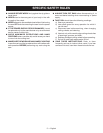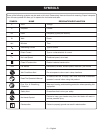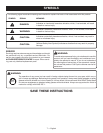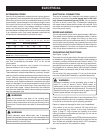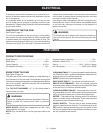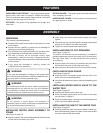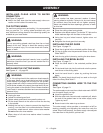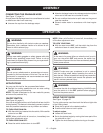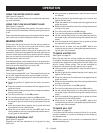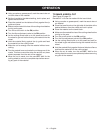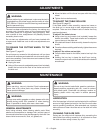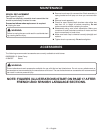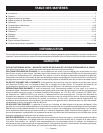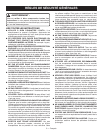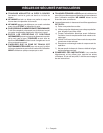
13 — English
OPERATION
USING THE WATER SUPPLY VALVE
See Figure 20, page 22.
The water supply valve allows you to adjust the water flow-
ing onto the wheel.
USING THE FLOW ADJUSTMENT VALVE
See Figure 21, page 22.
When using the pumpless flow system, this valve must be
turned on and off immediately following turning the saw on
or off.
When using the optional pump (not included), the flow adjust-
ment valve can be used to adjust the flow of water.
MAKING CUTS
Always draw the line to be cut on the tile using a marker or
grease pencil. If the tile is shiny and hard-to-mark, place
masking tape on the tile and mark the tape.
A common problem when cutting tile is straying from the
marked line. Once you’ve strayed from the mark, you can not
force the wheel back to the line by twisting the tile. Instead,
back up and recut the tile slicing off a small amount of tile
until the wheel is back on track.
To avoid this problem, use the bevel block or rip guide when-
ever possible. Use the rip guide when making cross cuts and
miter cuts and the bevel block for bevel cuts.
TO MAKE A CROSS CUT
See Figure 22, page 22.
Cross cuts are straight 90° cuts. The material is fed into the
cut at a 90° angle to the wheel, and the wheel is vertical.
Using a marker or grease pencil, mark the area to be cut
on material.
Set the rip guide to 0°, tighten the lock knob, and lock in
place.
Place the material on the table and firmly against the rip
guide and fence.
Make sure the material is clear of the cutting wheel before
turning on the saw.
Turn the on/off switch to the ON position.
Turn the flow adjustment valve to the ON position.
Let the cutting wheel build up to full speed and wait for
the wheel to get wet before moving the material into the
wheel.
Hold the material firmly against the rip guide and feed
the material into the cutting wheel.
When the cut is made, turn the saw OFF. Wait for the
cutting wheel to come to a complete stop before remov-
ing any part of the material.
TO MAKE A DIAGONAL CUT
See Figure 23, page 22.
Diagonal cuts are also referred to as “long point to long
point cuts”.
Using a marker or grease pencil, mark the area to be cut
on material.
Set the rip guide to the desired angle, lock in place, and
tighten the lock knob.
Place the material on the table and firmly against the rip
guide and fence.
Make sure the material is clear of the cutting wheel before
turning on the saw.
Turn the on/off switch to the ON position.
Turn the flow adjustment valve to the ON position.
Let the cutting wheel build up to full speed and wait for
the wheel to get wet before moving the material into the
wheel.
Hold the material firmly against the rip guide and feed
the material into the cutting wheel.
When the cut is made, turn the saw OFF. Wait for the
cutting wheel to come to a complete stop before remov-
ing any part of the material.
TO MAKE A MITER CUT
See Figure 24, page 22.
Miter cuts are used for cutting outside and inside corners
on material, decorative chair rail, and base molding with the
material at any angle to the wheel other than 90°. Miter cuts
tend to “creep” during cutting. This can be controlled by
holding the workpiece securely against the rip guide.
Using a marker or grease pencil, mark the area to be cut
on material.
Set the rip guide to the desired setting, lock in place, and
tighten the lock knob.
Place the material on the table and firmly against the rip
guide and fence.
Make sure the material is clear of the cutting wheel before
turning on the saw.
Turn the on/off switch to the ON position.
Turn the flow adjustment valve to the ON position.
Let the cutting wheel build up to full speed and wait for
the wheel to get wet before moving the material into the
wheel.
Hold the material firmly against the rip guide and feed
the material into the cutting wheel.
When the cut is made, turn the saw OFF. Wait for the
cutting wheel to come to a complete stop before remov-
ing any part of the material.
TO MAKE AN L-CUT
See Figure 25, page 23.
L-cuts are cuts that remove a piece of tile to fit in a corner,
around a cabinet, or a piece of molding and are made by
two separate cuts.
NOTE: Only overcut on the bottom or underneath side of
the material being cut.



